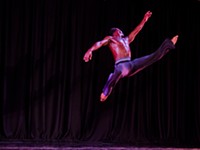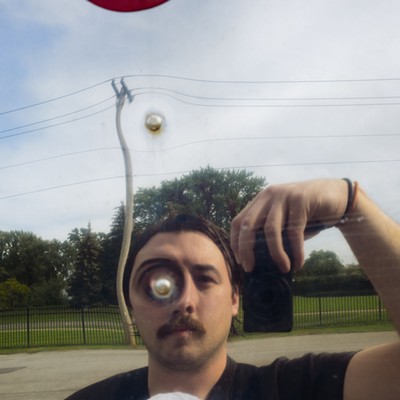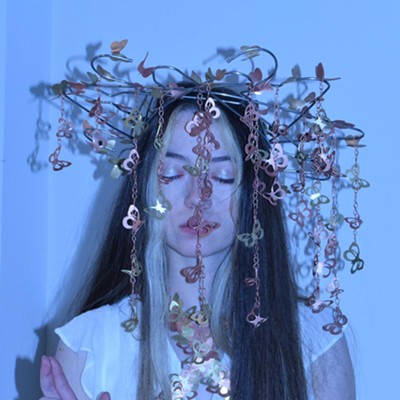[
{
"name": "500x250 Ad",
"insertPoint": "5",
"component": "15667920",
"parentWrapperClass": "",
"requiredCountToDisplay": "1"
}
]
Though each of us may know we are not the center of the universe, we cannot shake the fact that we experience this world in terms of how everything relates to the self. This whirling, messy, and perfect dance of (hopefully) ever-increasing awareness and growth is explored in "Insight, The Inner Nature of Things," an exhibition of new sculptural work by Mahine Rattonsey, Francesca Lalanne, Kate Roberts, and Jennifer Schinzing.
"Insight" is curated by Elizabeth Lyons, sculptor, designer, and founder and director of More Fire Glass Studio. Lyons selected the four artists because of their powerful commitment to introspection, and their ability to communicate the inner nature of things through sculpture. In this exhibit, themes of knowing the self, in relation to the family and to others, to death, beauty, nature, and impermanence are explored in personal and universal terms, through a variety of media.
In the mad rush of modern life, we don't always take the time for reflection. Self-reflection can be the most difficult form of all, but occasionally we're confronted with certain realities about ourselves. For example, a sudden, crystallizing observation of a parent's traits and habits can help us make a new kind of sense of ourselves. For Mahine Rattonsey, motherhood has only enhanced what was already an evident knack for self-reflection. "As I observe my 5-year-olds grow and acquire their personalities, and see so many of my traits reflected back at me, I couldn't help but wonder what it is that makes us who we are," says the artist in a provided statement.
Rattonsey explores the tension between the selves we present to the world and the traits we attempt to conceal — intentionally or not, and even from ourselves — through the symbol of the hand mirror, which is recurrent through her work. In a way, the personal mirror serves also as a magnifying glass, an intimate, focusing lens, "eliminating everyone else from the tableau but the viewer," she says.
In "Reflections," a collection of wall-mounted hand mirrors and assemblages with mirrored surfaces are altered with different objects and imagery, including thorns, maps, photographs, money, DNA, music, and keys, symbolizing different traits of personality and personal history. The accuracy of what we see is challenged in "Semblance," a wall-mounted wood case filled with painted outlines of hand mirrors, each with a highly distorted quicksilver surface.
Francesca Lalanne explores identity, relationships, and the epic personal journey in her paintings, sculptures, drawings, installations, and videos. A crudely formed human figure is consistently a central aspect in her work. The monolithic, powerful vessel-form is often depicted with a little void cut in the belly, perhaps indicating a soul's reliquary or a marker of never-settled human striving. In the body of work in this show, "Crusader," several shimmering golden figures lie prone, with unplugged electric cords trailing from them.
"Know Your Worth — Homage to Frida Kahlo's Wounded Deer" is a mixed-media work of a stag leaping in a void, representing the self. "There is always an underlying narrative, fragmented in time and space, which seeks to confront issues about womanhood, vulnerability, sacrifice, strength, relationship, and spirituality," says Lalanne in the provided statement. "I have used my own experiences and the experiences of the women in my family to steer through the series. 'Crusader' is an inner campaign for self-analysis, retrieval, and affirmation."
"Battleship" is a glittering gold figure-vessel with a frosted glass window where the void would usually be found in Lalanne's other works. This figure stars in "Crusade — Part I: Recollection," a four-minute animated video. The right frame stays fairly consistent, with a swinging, pixilated form marking off moments in time, but the left frame takes us on a journey through different territories and connections, with the enigmatic leaping deer never far behind the person-ship.
Resting on low platforms in the center of the gallery space is Kate Roberts' "Cat on a Hot Tin Roof," two white masses of glazed porcelain and slip clay, each resembling some sun-bleached, uprooted organic thing in a state of desiccation. Roberts' work is rife with ruin, and "based on a curiosity of the nature of time," per her artist statement. Roberts says she wishes to "understand the impermanent physicality of an object or idea and our relationship to it."
On a pedestal, "Depression" is a dark, lacy porcelain structure that seems built up out of a bed of delicate black leaves and flowers, but perhaps is also being picked apart by the insistent floral overgrowth. In "Anger," a similarly fragile bit of architecture leans, the home pushed by an insidious, insistent tide of heavy, matte black leaves. Roberts' work is both a concrete snapshot of the fleeting or flowering modes of unrest we experience, and a portrait of the damage those states can cause.
Jennifer Schinzing underscores the beauty and preciousness of all manner of mortal vessels by prominently featuring taxidermy animals in her sculptural works. The shells of birds and small animals sourced from road kill, or unpreventable deaths, are placed lovingly within ornate cases, under decorative bell jars, or on platters surrounded by jewel-like representations of the natural world.
The elegant arrangements of the immortalized forms, combined with glass elements and shrine-like settings, pay tribute to the fragility and beauty of our physical world. In "Dichotomy," two pigeons are mounted directly on the wall, circled by gold frames, and adorned with small glass and gold crowns. "Appurtenance" is a glass-and-wood box in which a duck rests, leathery feet and long neck tucked inward toward an open chest cavity, providing an intimate and surreal peek into the fragile mechanics. It's a metaphor that makes repair seem complicated, but possible with proper skill.
But Schinzing's work is also a metaphor for our cycling through the death of ideas and states, and our capacity for resilience and recreating ourselves. "From every death comes a breath of new life, giving us a glimmer, a feeling of repair," she says in her provided statement. In "Heal," a mourning dove lay on its back, wings outstretched to frame the flames of glass flowers rising from its heart, phoenix like.
Speaking of...
-
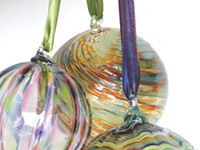
Deck all of the halls
Nov 25, 2015 -
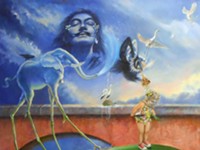
Art Review: "Proverbs and Commonplaces"
May 21, 2014 -

Perception of people and place
May 7, 2014 - More »
Latest in Art
More by Rebecca Rafferty
-

Beyond folklore
Apr 4, 2024 -

Partnership perks: Public Provisions @ Flour City Bread
Feb 24, 2024 -

Raison d’Art
Feb 19, 2024 - More »

